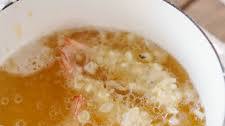Crispy Perfection: Mastering the Art of Tempura Batter

The Art of Tempura Batter: A Crispy Delight
Tempura batter is a culinary gem that has captured the hearts of food enthusiasts around the world. This light and crispy coating, originating from Japan, has become a staple in many international cuisines, adding a delightful crunch to an array of dishes.
The secret to perfect tempura batter lies in its simplicity. Typically made from a mixture of flour, water, and sometimes egg or baking soda, the batter is gently whisked to just the right consistency – not too thick, not too thin. The goal is to achieve a delicate coating that crisps up beautifully when fried.
One key element in creating exceptional tempura batter is using ice-cold water. The cold temperature helps prevent gluten formation in the flour, resulting in a lighter and crispier texture once fried. Some chefs even go as far as chilling the flour beforehand to ensure the batter stays cold throughout the cooking process.
When it comes to ingredients for tempura batter, simplicity is key. High-quality flour, such as wheat or rice flour, is commonly used for its lightness and ability to create that signature crispy texture. Some variations may include cornstarch or even sparkling water for added airiness.
Whether you’re dipping vegetables, seafood, or even fruits into this golden concoction, one thing remains constant – the satisfaction of biting into a perfectly fried piece of tempura. The light crunch followed by a burst of flavour from the tender interior is a sensory experience like no other.
So next time you’re craving something crispy and delicious, consider trying your hand at making tempura batter at home. With just a few simple ingredients and some practice with your frying technique, you too can enjoy the delightful crunch of this Japanese culinary delight.
Mastering Tempura: Ingredients, Techniques, and Tips for Crispy Perfection
- What is tempura batter made from?
- What is the secret to perfect tempura?
- Why is tempura so crispy?
- Should you salt tempura batter?
What is tempura batter made from?
Tempura batter is typically made from a simple mixture of flour, water, and sometimes egg or baking soda. The key to achieving the perfect tempura batter lies in the balance of these ingredients and the consistency of the batter. By gently whisking together flour and ice-cold water, chefs aim to create a light and airy coating that crisps up beautifully when fried. While variations may exist, the fundamental components of flour and water remain essential in crafting this beloved crispy coating that enhances the flavour and texture of various foods.
What is the secret to perfect tempura?
Achieving the perfect tempura lies in mastering a few key secrets. The first secret is using ice-cold water in the batter to maintain a light and crispy texture. This cold temperature prevents gluten formation in the flour, resulting in a delicate coating that crisps up beautifully when fried. Another secret is ensuring the batter is not overmixed – gentle whisking is key to maintaining its lightness. Additionally, using high-quality flour, such as wheat or rice flour, contributes to the desired crunchiness. Lastly, frying the tempura at the right temperature is crucial for achieving a golden exterior while keeping the interior tender and flavourful. By combining these secrets with practice and patience, one can unlock the art of creating perfect tempura every time.
Why is tempura so crispy?
Tempura is renowned for its irresistibly crispy texture, which can be attributed to a few key factors. Firstly, the use of ice-cold water in the batter helps to inhibit gluten formation in the flour, resulting in a light and airy coating when fried. This prevents the batter from becoming dense and ensures that it crisps up beautifully. Additionally, the high heat used in the frying process causes rapid evaporation of moisture within the batter, creating those sought-after crunchy bubbles and a delicate crispness. The combination of these techniques and ingredients results in tempura’s signature crispy exterior that keeps food lovers coming back for more.
Should you salt tempura batter?
When it comes to salting tempura batter, opinions among chefs and home cooks vary. Some argue that adding salt to the batter can enhance the overall flavour profile of the dish, while others believe that salt can affect the texture of the batter, potentially making it denser or less crispy. Ultimately, whether or not to salt tempura batter is a matter of personal preference. Experimenting with small batches and adjusting the seasoning to suit your taste buds may help you find the perfect balance between flavour and texture in your tempura creations.

